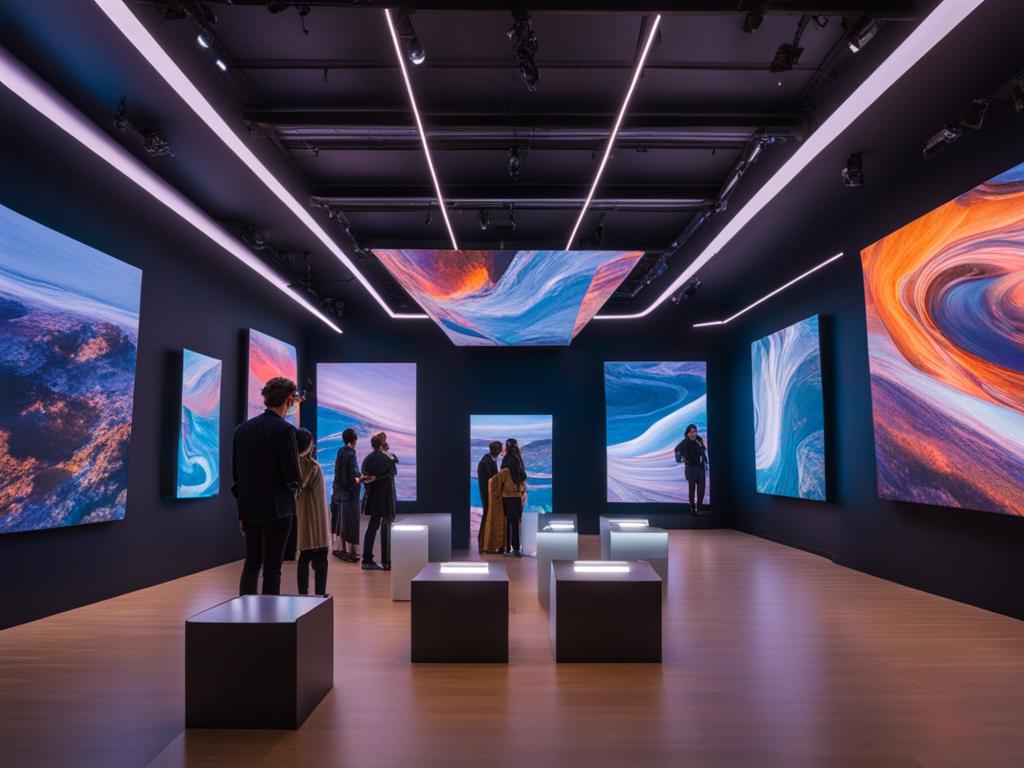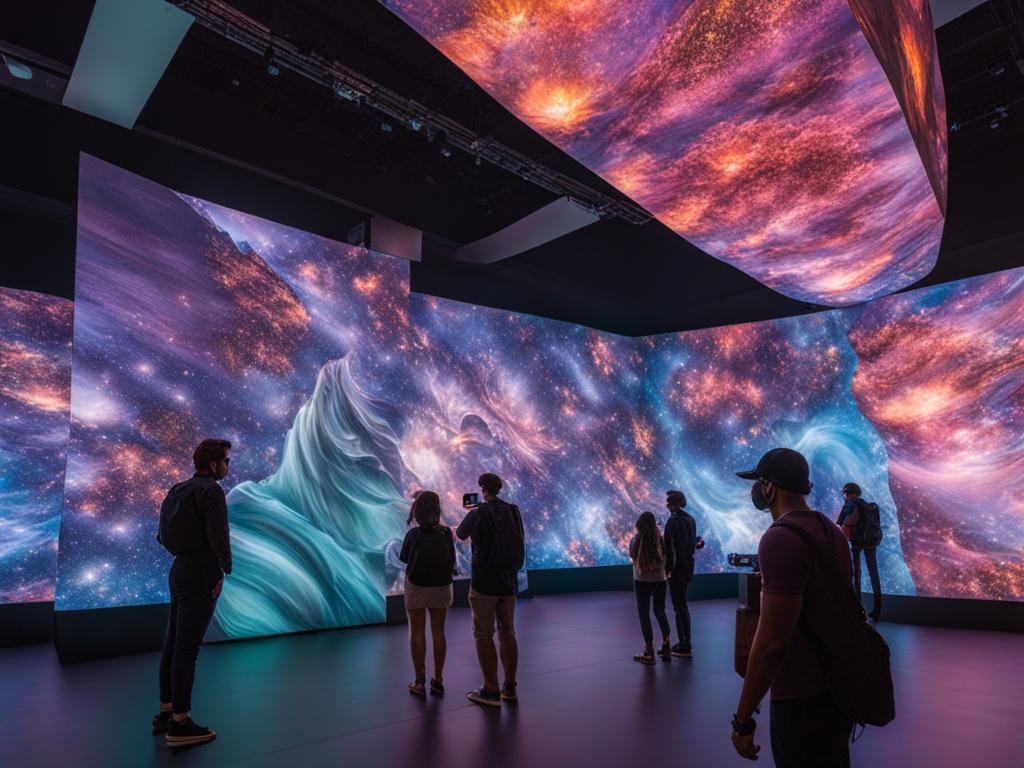As a technology enthusiast and an art lover, I am fascinated by the increasing popularity of virtual reality art in the market. In recent years, VR art has rapidly gained traction, creating new avenues for artistic expression and transforming the art industry in novel ways.
The availability of advanced VR technology has enabled artists to create immersive and interactive experiences that go beyond traditional art forms. Through virtual reality, artists can transport viewers to other worlds and engage them in unique ways.
In this article, we explore the latest trends in VR art and the impact they are having on the art world. We discuss the emergence of virtual reality art galleries and exhibitions and how they are changing the way we experience art. We also delve into the techniques used in VR art and the challenges and opportunities they present for artists and viewers alike.

Join me on this journey through the evolving landscape of virtual reality art market, and discover the future possibilities of this rapidly growing medium.
Evolution of Virtual Reality Art
Virtual reality art has come a long way since its inception. Early experiments with virtual environments in the 1970s and 1980s paved the way for more elaborate and interactive VR experiences in the art world. As VR technology has advanced, artists have embraced it as a tool for creating immersive and innovative works of art.
With the advent of more powerful computers and advanced graphics processors, artists can now create incredibly detailed and realistic virtual worlds. Some contemporary virtual reality artists even incorporate haptic feedback and spatial sound into their works to create a more engaging and multisensory experience for viewers.
Virtual reality has also transformed the traditional art-making process. Instead of using traditional media like paint and canvas, virtual reality artists use software and digital tools to sculpt, animate, and manipulate their creations. This shift in art-making techniques has led to new modes of artistic expression and a new generation of virtual reality artists who are pushing the boundaries of this exciting new medium.
Techniques in Virtual Reality Art
Virtual reality artists use a variety of techniques to bring their worlds and characters to life. These techniques not only require a mastery of traditional art skills but also a deep understanding of the technology and tools that power VR experiences. Here are some of the most commonly used techniques in virtual reality art:
- 3D Modeling and Animation: This technique involves creating 3D digital models of characters, environments, and objects, followed by motion graphics that bring them to life and convey emotion and movement.
- Spatial Sound: Virtual reality art often incorporates spatial sound, which creates a sense of depth and immersion by simulating how sound waves are affected by the movement and position of the viewer.
- Haptic Feedback: Haptic feedback uses tactile sensations, such as vibrations and pressure, to simulate physical interaction with virtual objects and environments.
Other techniques include:
- Photogrammetry – a technique for creating 3D models using photographs
- Interactive storytelling – allowing the viewer to be part of the story and make decisions
- Virtual sculpting – using VR tools to sculpt and manipulate 3D objects in a virtual space
Virtual reality artists combine these techniques to create immersive, interactive experiences that blur the line between art and technology. As VR technology continues to evolve, we can expect to see even more innovative techniques and approaches to virtual reality art in the future.
Impact of Virtual Reality Art on the Art World
Virtual reality art has revolutionized the art world in myriad ways. By challenging traditional conventions, it has expanded the possibilities of artistic expression, leading to a renaissance in immersive and interactive art experiences. This has fueled a new dialogue between artists, critics, and viewers, and redefined the role of the art gallery in the virtual sphere.
One of the most significant impacts of virtual reality art has been its ability to democratize the art world. In the past, only a privileged few could afford to experience the works of famous artists in the flesh. However, virtual reality has made art accessible to anyone with a headset and an internet connection. This has not only increased the audience for art but also allowed artists to connect with viewers on a more personal level.
Moreover, virtual reality art allows artists to create immersive art installations that transcend the physical limitations of traditional art exhibitions. Virtual reality art installations can be limitless in scale, size, and complexity, enabling artists to push the boundaries of artistic expression. This has led to the creation of experiential art shows that create a visceral impact on the viewer, tapping into new emotional and sensory experiences.
“Virtual reality art has changed the way we approach art experiences. It has created an entirely new way for viewers to interact and engage with artwork, and it’s one that artists are enthusiastically taking advantage of. I believe that VR art has the potential to change the way we think about art-going, art collections, and art exhibitions in the years to come.” – Jessy Kendall, Virtual Reality Art Curator
Virtual Reality Art Galleries and Exhibitions
Virtual reality has not only revolutionized the way artists create, but it has also transformed the way art is exhibited and experienced. With the rise of virtual reality art galleries and exhibitions, viewers can immerse themselves in the artwork like never before. These virtual space galleries offer a unique opportunity for artists to showcase their work to audiences worldwide, without the barriers of physical distance.
Discover some of the most exciting virtual reality art galleries and exhibitions below:
| Virtual Reality Art Gallery | Location | Description |
|---|---|---|
| VorticXR | Online | A virtual gallery space showcasing contemporary art exhibitions and installations from around the world using VR, AR and XR technologies. |
| The VR Museum of Fine Art | Online | A virtual museum with a collection of world-renowned paintings and sculptures, including works by Monet, Van Gogh and Rodin. |
| VR ALL ART | Berlin, Germany | A virtual reality art gallery that offers original VR artwork, installations and exhibitions from around the world. |
As virtual reality technology continues to advance, we can expect to see even more virtual reality art galleries and exhibitions emerge, delivering unique and innovative art experiences to audiences around the globe.

Enhancing the Viewer Experience with Virtual Reality Art
Virtual reality art experiences have revolutionized the way we interact with art. They provide a unique opportunity for viewers to immerse themselves in the artwork and explore it from various angles. This makes the experience more engaging and interactive, allowing for a deeper understanding of the artist’s message.
Through virtual reality, viewers can travel through time and space, experiencing different eras, cultures, and environments. They can also interact with the art in ways that were previously impossible, such as manipulating objects, altering colors and shapes, and even becoming part of the artwork.
However, experiencing virtual reality art comes with its own set of challenges and opportunities. The immersive experience can be overwhelming for some viewers, and the use of technology can detract from the traditional idea of art. On the other hand, virtual reality art can open doors to new forms of expression and create a more inclusive and accessible art world.
“Virtual reality art is an exciting medium that opens up new possibilities for expression. By providing an immersive experience, it allows viewers to engage with art in a way that was never possible before.”
Virtual Reality Art Trends
Virtual reality art continues to evolve and push boundaries, with emerging trends that showcase the medium’s endless possibilities. From political and social commentary to abstract and experimental forms of expression, virtual reality artists are exploring new avenues of creativity. Let’s take a closer look at some of the key trends shaping the virtual reality art landscape:
| Trend | Description |
|---|---|
| Interactive Installations | Virtual reality installations allow viewers to immerse themselves in interactive experiences, blurring the lines between art and technology. |
| Environmental Consciousness | Virtual reality art often addresses environmental issues, encouraging viewers to take action and be more mindful of their impact on the planet. |
| Experimental Narratives | Many virtual reality artists are pushing the boundaries of traditional storytelling by creating abstract, non-linear narratives that challenge viewers’ expectations. |
| Collaborative Projects | Virtual reality art often involves collaborative efforts between artists, programmers, and other experts, resulting in dynamic and engaging experiences. |
As virtual reality technology continues to advance, we can expect to see even more exciting trends emerge in the world of VR art.
Virtual Reality Art and Traditional Art Forms
In recent years, virtual reality art has grown in popularity and become a force to reckon with in the art world, challenging traditional art forms. VR art is an innovative creative process that involves using technology to develop artistic experiences that are new and unique. However, virtual reality art doesn’t exist in a vacuum, and it intersects with traditional art forms such as painting and sculpture.
Traditional art forms like painting and sculpture have been in existence for centuries and continue to be immensely popular today. Artists in these mediums often produce pieces that reflect significant moments in history, social issues, and personal experiences. While virtual reality art aims to create immersive and interactive experiences, traditional art forms emphasize the beauty of a medium and its elements, such as line, color, form, and texture.
Despite their differences, virtual reality art and traditional art forms can coexist and even merge to create beautiful hybrid pieces. Virtual reality artists are now exploring how they can combine the traditional art forms with virtual reality, such as by rendering a sculpture in virtual reality or painting in 3D with virtual reality tools. This blending of virtual and physical elements can produce works that are both awe-inspiring and thought-provoking.
It is worth noting that even as virtual reality art and traditional art forms merge, the two still have some differences. For example, virtual reality art creates immersive and interactive art experiences, while traditional art forms tend to be static, focusing more on the beauty of the medium and its elements.
As virtual reality art continues to evolve and become more accessible and integrated into the art world, it will be exciting to see how artists continue to merge the traditional art forms with virtual reality to create unique and engaging pieces.
Future Possibilities of Virtual Reality Art
As someone who has followed the evolution of virtual reality art, I am excited to see where the technology takes us in the future. With advancements in VR technology and continued experimentation by artists, the possibilities for immersive art experiences are endless.
One area of development that I am particularly excited about is the potential for virtual reality art to evolve beyond the confines of traditional exhibition spaces. With the ability to create fully immersive environments, VR art has the power to transport viewers into entirely new worlds and experiences.
Another exciting possibility is the integration of physical and virtual elements in art installations. By merging the digital and physical realms, artists can create hybrid experiences that engage multiple senses and challenge our perception of reality.
As VR technology becomes more accessible and user-friendly, we may even see a rise in VR art experiences created by non-artists. With platforms like Google’s Tilt Brush and Oculus Medium, anyone can jump into the world of VR art and create their own immersive creations.
Overall, the future of virtual reality art is bright, and I cannot wait to see how artists continue to push the boundaries of what is possible with VR technology.
